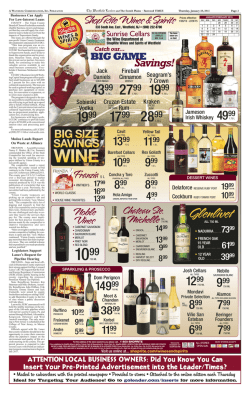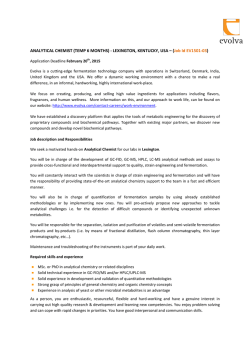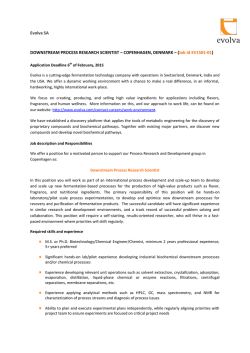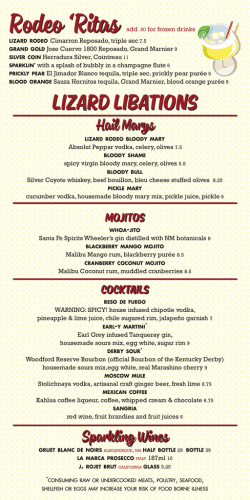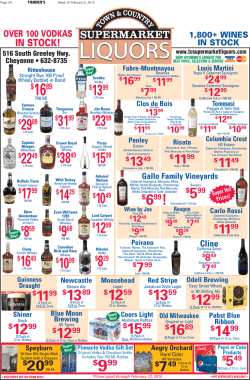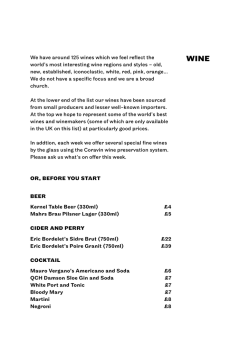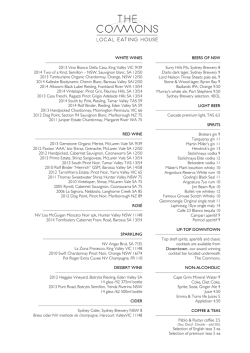
Download (297kB) - Munich Personal RePEc Archive
M PRA Munich Personal RePEc Archive Influence of non-saccharomyces yeasts on white dry wines Alain Poulard and Xenia Pascari and Boris Gaina Institut Fran¸cais de la Vigne et du Vin, Nantes, France, Technical University of Moldova, Academy of Science of Moldova 20. November 2014 Online at http://mpra.ub.uni-muenchen.de/61732/ MPRA Paper No. 61732, posted 1. February 2015 06:27 UTC INFLUENCE OF NON-SACCHAROMYCES YEASTS ON WHITE DRY WINES POULARD ALAIN1 PASCARI XENIA2 GAINA BORIS3 Abstract: It was demonstrated a positive action of the non-Saccharomyces yeasts on the organoleptic properties of wines. Also, their participation in fermentation process did not involve an excessive accumulation of volatile acidity or other taste and aroma defects. The involvement of the non-Saccharomyces yeasts in practical oenology that keeps on recent achievements in oenological biotechnologies allow an increase of aromatic intensity (floral, fruitful etc.) in varietal wines and preserve the varietal identity of obtained wines. Key words: yeasts, non-Saccharomyces, Saccharomyces cerevisiae, alcoholic fermentation, kinetics of alcoholic fermentation, white dry wines. INTRODUCTION The last years the non-Saccharomyces yeasts have become increasingly studied dues to those technological proprieties. Many works refer to those benefic influences on the white dry wines [2, 3, 4, 5, 7]. In view of the above, several non-Saccharomyces strains were proposed for cofermentation process in association with Saccharomyces cerevisiae. French Institute of Vine and Wine (Nantes) last ten years were studied the fermentation process, its kinetics and also organoleptic and physic-chemical characteristics of produced wines from Melon B and Sauvignon varieties. MATERIALS AND METHODS The research objective supposes the association of non-Saccharomyces yeasts with Saccharomyces cerevisiae in sequential seeding to prove the positive changes involved by these strains. Non-Saccharomyces strains targeted in this study are: Candida pyralidae, Metschnikowia pulcherrima, Torulaspora delbrueckii. Candida pyralidae is a selected strain that was studied earlier at the French Institute of Vine and Wine (Nantes). It has an oenological interest in enriching wine with aroma. The other two tested strains (Metschnikowia pulcherrima and Torulaspora delbrueckii) are already recommended to be produced and marketed. During this study were used three Lots of different varieties and geographical provenience: LOT 1: Melon de Bourgogne, LOT 2 : Sauvignon de Poitou, LOT 3 : Sauvignon de Touraine. Given the trends of last years of substitution of manual harvest with mechanical, in all three Lots the harvest was perform using the combine and received as marc (Melon B) and must (Sauvignon). The success of implantation of the strains was verified by performing an implantation control when the density of musts was ranged between 1,020 and 1,030 g/dm3. Biomass analysis was realized by amplification Polymerase Chain Reaction (PCR). The genetic profile of biomass recovered from must, compared with referential strain allow the validation of successful yeast implantation. In order to determine the basic physical and chemical indexes were used recommended a standardized methods proposed by OIV [6]. 1 Institut Français de la Vigne et du Vin, Nantes, France Technical University of Moldova 3 Academy of Science of Moldova 2 RESULTS AND DISCUSSIONS The analytical composition of every lots is different and especially in assimilable nitrogen. In order to ensure a reliability of alcoholic fermentation, in this study it was proceed to an increase of nitrogen content by using alcoholic fermentation activators „Go Ferm„ and „Fermaid E„ in two halves. Table 1 presents an analytical composition of 3 lots of must. Table 1: Analytical composition of musts Melon B Sauvignon de Poitou Indexes Total acidity, g/l H2SO4 pH Assimilated nitrogen, mg/l Tartric acid, g/l L-malic acid, g/l Turbidity,NTU Potential alcohol concentration, % vol Carbohydrates concentration, g/l 4.0 (82 me/l) 3.20 66 2.9 (38 me/l) 5.7 (85 me/l) 100 10.0 6.42 (131 me/l) 3.08 190 3.9 (52 me/l) 8.8 (131 me/l) 50 10.0 Sauvignon de Touraine 5.0 (102 me/l) 3.17 55 4.1 (54 me/l) 7.0 (104 me/l) 110 12.0 166 166 195 Analysis results show a fundamental difference in assimilable nitrogen concentration, ranging from 55 to 66 g/l for Touraine Sauvignon and Melon B but up to 190 g/l for Poitou Sauvignon. Also, the total acidity range from 4,0 g/l in Melon B must up to 6,42 g/l in those obtained from Poitou Sauvignon. Chemical composition of must, as well as the interactions that occur between pairs of strains involved in every fermentative process influence first of all the duration of the fermentation (table 2). Table 2: Comparative characteristics of fermentative activity of yeasts Yeasts strains Melon B Alcoholic Fermention, days 1 Saccharomyces cerevisiae Torulaspora delbrueckii Candida pyralidae 2% Candida pyralidae 3% Candida pyralidae 5% Metschnikowia pulcherrima Metschnikowia pulcherrima IFV Latenc y Duratio n 2 1 3 20 2 Sauvignon de Poitou Residual sugar before sulfitage, g/l Alcoholic Fermention, days Latenc y Duratio n 4 1.8 5 2 6 16 28 1.9 2 3 20 1.9 3 20 3 Sauvignon deTouraine Residual sugar before sulfitage, g/l Alcoholic Fermention, days Residual sugar before sulfitage, g/l Latenc y Duratio n 7 2.0 8 3 9 10 10 1.9 25 2.5 4 35 2,0 2 23 1.9 3 24 1.9 1.8 2 23 2.0 3 24 1.9 20 1.9 2 25 2.5 3 10 2.0 3 22 1.9 2 16 1.5 3 10 1.8 4 20 1.8 2 11 1.25 3 10 1.5 Table 2 results shows a difference in duration (days) of alcoholic fermentation carried out with Saccharomyces cerevisiae strain in 24 hours, while, under the same experimental conditions, this characteristic for Torulaspora delbrueckii and Candida pyralidae strains was respectively 48 and 72 hours. In terms of the duration of fermentation of must, it is observed only small deviations for experimented varieties, being higher in Melon B and quasi identical in the two lots of Sauvignon. Also, the interactions between strains and the fermentation kinetics will alter (figs 1). The curves of each series had a similar shape to that of the reference sample (seeded with Saccharomyces cerevisiae), but the using of non-Sachharomyces yeasts increase the latency period because of the concurrence between the strains. Torulaspora delbrueckii provides a quick beginning of alcoholic fermentation but towards the end the sugar consumption decrease and the fermentation slows compared to the previous steps. This can be seen in all launched lots. Metschnikowia pulcherrima, didn’t involve fermentation difficulties in any sample, also its competition with Saccharomyces is less noticeable. Regarding to Candida pyralidae strain, the graphs are quasi identic, showing that the initial number of microorganisms doesn’t involve changes in duration and speed of alcoholic fermentation of the musts. The alcoholic fermentation of Lot Nr2 (Poitou Sauvignon) took place in a higher speed than the other two lots but the curves of lot Nr3 (Touraine Legend: LT1-TD-Torulaspora delbrueckii LT1-RnMO2-Candida pyralidae 2% LT1-RnMO3-Candida pyralidae 3% LT1-RnMO5-Candida pyralidae 5% LT1-SC-Saccharomyces cerevisiae LT1-MP- Metschnikowia pulcherrima LT1-MPL8- Metschnikowia pulcherrima selecționată la IFV Figure 1: Alcoholic fermentation kinetics of Lot Nr1 (variety Melon B) Sauvignon) have greater slopes at the beginning, showing that the fermentation speed decrease with the decrease of the content of sugar and increase of the content of alcohol. A table 3 summarizes the analytical composition of produced wines. Table 3: Analytical composition of obtained wine from variety Melon B (Lot 1) Indexes Melon B Candida Candida pyralidae pyralidae 3% 5% Saccharomyces cerevisiae Torulaspora delbrueckii Candida pyralidae 2% Metschnikowi a pulcherrima Metschnikowia pulcherrima IFV Alcohol concentration , % vol Glucose+Fructo se, g/l Total acidity (in H2SO4), g/l Volatile acidity corrected (in H2SO4), g/l pH IRTF 12.48 12.37 12.43 12.43 12.32 12.79 12.35 1.3 0.6 1.2 0.9 1.3 <0.4 1.2 4.19 4.15 4.02 4.11 4.01 4.10 4.14 0.21 0.51 0.24 0.23 0.23 0.33 0.27 3.23 3.28 3.25 3.23 3.24 3.24 3.22 L-malic Acid, g/l Tartric Acid, g/l Total sulfure dioxide (total SO2), mg/l 5.0 4.1 4.4 4.3 4.5 4.6 4.7 1.4 89 1.6 24 1.3 113 1.4 83 1.4 107 1.4 14 1.5 100 According to table 3, the alcoholic fermentation was finished in all samples (residual sugar <2 g/l). Meanwhile, the alcohol by volume of obtained wines do not show much difference, except the lot seeded with Metschnikowia pulcherrima, that the analysis may be supposed an error. The total acidity of samples was within normal limits for the product. Despite the existing opinion, the results show that the seeding with non-Saccharomyces do not involve a rising of volatile acidity of wines. Although the sample seeded with Torulaspora delbrueckii has a higher volatile acidity than other samples of the same series (0,51 g/l), but its value is within the limits allowed for white wines. The activity of non-Saccharomyces yeast involved a high consumption of tartric and malic acids (reducing concentrations with 1,0-1,5 g/l inj relation to the initisl content of these acids in must). The sensorial analysis of wines at this stage cannot give the definitive results on the quality of products but provides an objective opinion on the ulterior development of wine during maturation. The samples do not show important organoleptic defects. The intensity of aroma and taste of the products was determined both by yeasts activity and aromatic varietal potential of grapes. Overall, the most appreciate was the Lot 2 (Poitou Sauvignon) because of more pronounced secondary aroma and a balanced taste (figure 2). The results of organoleptic analysis are listed in figure 2. Legend: TD-Torulaspora delbrueckii RnMO2-Candida pyralidae 2% RnMO3-Candida pyralidae 3% RnMO5-Candida pyralidae 5% SC-Saccharomyces cerevisiae MP- Metschnikowia pulcherrima MPL8- Metschnikowia pulcherrima selecționată la IFV Figure 2: Sensorial analysis of wines (Lot 1) CONCLUSION It was demonstrated the positive action of non-Saccharomyces yeasts on the organoleptic characteristics of wines. At the same time, their involvement in fermentation process doesn’t achieve an excessive volatile acidity and other defects of aroma and taste. The involvement of nonSaccharomyces strains in practical oenology that keeps recent achievements in oenological biotechnologies allows an increase of aroma intensity (floral, fruitful etc.) in varietal wines with preservation of varietal aromas and taste in natural dry wines. BIBLIOGRAPHY 1. CLAUDE FLANZY, « Oenologie –fondements scientifique et technologiques», Lavoisier TEC&DOC, 1998, pag. 165-219 2. « Application à l’oenologie des progrès récents en microbiologie et en fermentation », Office International de la Vigne et du Vin. ENSAA Dijon, ENSA Montpellier 1998, pag.171-202 3. RIBEREAU-GAYON J., PEYNAUD E., ,, Traité d’œnologie’’ . Vol I, Paris et Liège, 1960. 4. ,, Maîtrise des fermentations spontanées et dirigées’’, ITV-Nantes, 2008, pag.26 5. HUET Myriam, LAUZERAL Valérie ,, Dictionnaire des vins et alcools’’ , Edition Hervas,1999, pag. 440 6. Recueil des méthodes internationales d’analyse des vins et des moûts, OIV, volume 1, Paris, edition 2011 7. Alain Poulard, Xenia Pascari, Rapport de stage « Sélection d’une souche non-Saccharomyces pour la fermentation des vins blancs », Institut Francais de la Vigne et du Vin, 2013, 54 pages. 8. Gherciu-Musteţă Lidia, Poulard Alain, Gore Ecaterina, « Etude de la fermentation alcoolique en flores mixtes sur Melon de Bourgogne », Technical University of Moldova, 2009, 16 pages.
© Copyright 2026
